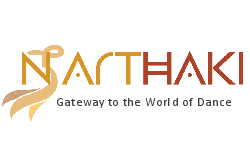
|   |

|   |
Invigorating dialogues, intense workshop and superb performances at Nrityaparva '25 - Manjari Sinha e-mail: manjari@sinha.com February 22, 2025 Prof. Parul Shah, and the Anjali Memorial Committee (AMC), Vadodara have been organising Nrityaparva in memory of their Late Guru Prof. Anjali Merh ni Hora (1928-1979) for the past decades. One of the very first students of Rukmini Devi Arundale at Kalakshetra, Anjali was a renowned Bharatanatyam dancer, choreographer and educator who played a vital role in building and strengthening dance education in post-independence India. Kulapati K.M. Munshi invited her to teach dance at the Bharatiya Vidya Bhavan as the Principal of Bhavan's Sangeet Nartan Shikshapeeth, before she joined Maharaja Sayajirao University Baroda, first as a visiting professor and then as the Head of Dance Department. Prof Anjali Merh developed not just the dance pedagogy and notation system but being a well-versed Hindustani and Carnatic musician, composed Kuravanji (Dance-Drama) in Gujarati and used Sanskrit and regional languages to write and compose compositions for students of Bharatanatyam who were not conversant with the Tamil language. Unfortunately, she died at a very young age of fifty years. What started as a tribute to their revered Anjali Ben by Dr Parul Shah and the AMC in 1981 has become a three-day festival of dance performances, seminars and workshops in her memory. The 45th edition of Nrityaparva was held this year from the 8th to the 10th of February, celebrating 75 glorious years of Indian Independence along with the 45 vibrant years of Nrityaparva bridging tradition with modernity, by showcasing the living tradition of classical dance in contemporary interpretations. Students at the Department of Performing Arts, M S University Baroda also benefitted from a Kalarippayattu workshop organised by AMC on this occasion. There was in addition, a round table dialogue and discussion by brilliant creative minds comprising sensitive scholars and practitioners from different fields, who spoke on 'Contemporary Sensibility in Traditional Forms W.R.T. Bharatanatyam', followed with enthusiastic floor participation and interaction.  Swati Datar and Swarada Datar Bhave Nrityaparva 2025 was inaugurated by Shubhangini Devi Raje Gaekwad, Chancellor of The Maharaja Sayajirao University of Baroda lighting the auspicious lamp with other dignitaries. 'Sakhya', a refreshing Bharatanatyam presentation, was the main attraction of the inaugural evening, presented by Dr Swati Datar, an acclaimed Bharatanatyam exponent, educator and founder director of Swarada Nritya Sanstha, Pune, along with Swarada Datar Bhave, her gifted daughter and disciple. Swarada is also trained under the Kalakshetra alumni Mythili Raghavan and Vaibhav Arekar. 'Sakhya' underlined friendship and understanding in a relationship, especially between a mother and a daughter who were also Guru and Shishya in the ocean of Art. This 'Sakhya Bhava' was beautifully portrayed through the imaginatively woven tapestry of Bharatanatyam Margam enhanced with live music, an added attraction. Opening with Natesha Kautuvam, a composition of Satish Krishnamurthy in Ragamalika and Talamalika, Swati emerged on stage as Natesha, the God of dance, standing still in the sculpturesque pose of Nataraja. The invocatory shloka "Omkar vachyam urag pungava bhushitangam......Kailas bhudharapatim pranatosmi nityam" was first recited and then sung in the swaras of raga Revathi by Sujesh Menon accompanied on mridangam by Prajesh Nair, on flute by Partha Sircar and on violin by Prarthana Sonia. The raga changed to Shyam Kalyan when Swarada joined her as the devotee of Nataraja, on the concluding aalap with the Mantrochchaar-like recitation of the shloka. 'Ardha-Narishwara', a composition of Muthusamy Dikshitar in raga Kumudakriya and rupak talam came next. This piece was focused on Shiva and Shakthi and beautifully joined by Kalidasa's "Jagatah pitarau vande Parwathi Parameshwarau" to conclude with, where the poet symbolises the duo as inseparable as the word and its meaning "Vagarthaviv Sampriktau'! 'Daru Varnam', the centre piece was a composition of Harikesanallur Mutthaiya Bhagavathar in raga Khamas, and adi tala, focused on Devi, who is the Adi-Shakthi and Adi-Maya, She is Shyam Varni, the nature herself, and which resides in all of us as the Kundalini Shakti. The fascinating duet by the mother-daughter duo brought out their equal command of nritta and abhinaya. The music gradually evolved like a Ragam-Tanum-Pallavi where Swati enacts the Devi with "Mathe swarabhagya sujathe" and Swarada enacts the Prakrithi or nature with its flora and fauna and cosmic energy. The Varnam caught a faster pace in Khanda Jathi mnemonics "Tak-Takit, Tak Takit", which created the aura of the fight scene between the Asura and the Chamundeshwari. The sargam sequence concluding with just the strumming of tanpura ended on a reflective note. 'Prahelika' next provided a comely contrast with light humour. Composed in Ragamalika and Talamalika, it was a thrilling tete-tete between the two dancers challenging each other with a puzzle to find the correct answer. The imaginative play of light and shadow handled here by the young light designer Dhara enhanced the overall effect. Nattuvangam by Ketaki also demanded special skill for the dialogue delivery of the Prahelika, where Ketaki excelled. The puzzles were in Sanskrit, such as, "Parvatagre ratho yaati / Bhumau tishthati sarathi. chalate vayu vegena padamekam na gachchhati." This meant the chariot reached the mountain but the charioteer stayed on the ground. The speed is as fast as the air but he doesn't take a single step. It was thrilling for the audience to guess while watching the dancers guessing the answers. Naturally, this one was a 'kite'. The other puzzles were about Mridangam, Shirt and Chutki. This game between the two friends, enhanced by appropriate music, nattuvangam, light and sound was a contemporary interpretation of the traditional Bharatanatyam. The Thumri "Saanvre ai jaiyo" had an imaginative catch to the abhinaya aspect of Bharatanatyam, where Swati calls Krishna lovingly as mother Devaki with vatsalya bhava the motherly love and the other dancer Swarada expresses her yearning for Krishna as Radha where her beckoning evokes shringar rasa. Both the dancers emoted each line on a parallel contrast in abhinaya. Kudos to Dr Parul Shah who, in these times of stardom, attempts to search for such hidden gems and showcases them in Nrityaparva year after year. 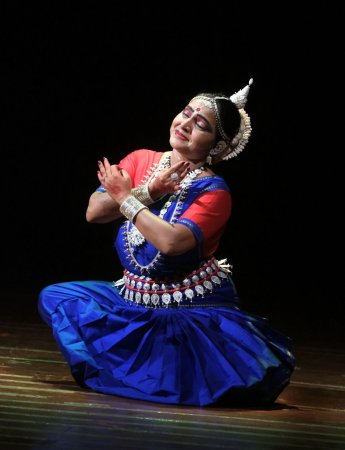 Swapnokalpa Dasgupta The second evening had two dance presentations - 'Kali' by the Odissi exponent Swapnokalpa Dasgupta and 'Nimitta' by the Kathak dancer Shila Mehta. Both of them performed on recorded music. Swapnokalpa assisted by three of her disciples presented various episodes on Kali, opening with Devi Stuti, "Kalikayai Namostute". Composed in Ragamalika, it opened with Kedar and ended with Bhairavi. Multiple tableaus were depicted in as many ragas. Frozen statues of Ashta Bhuja, Astra Shastra Dharini Devi in sculpturesque stances heralded applause. Married to Mahakala Shiva, Mahakali was Sada Anandmayi, the Chidananda in the next presentation. The music of this piece was composed in Shyama Sangeet. Harshita is another aspect of Devi, who is happy in every circumstance. Swapnokalpa selected three Nayikas from the traditional Ashta Nayikas to prove her point, such as the Vasaksajjika, Abhisarika and the Swadhinapatika. Swapna imaginatively used the Pallavi sections of nritta including a Sawal-Jawab sequence, to support her Bhava Paksha. The dancer included the ritualistic practices of the traditional Puja Festival in Bengal, with its last three days from 'Agomony' to 'Visarjan'. Agomony is the homecoming of Devi after marriage when she comes to her parent's house to spend some time with them. Soon her husband comes to fetch her back and she is given 'vidai', a see-off with joyous fanfare, with assurance of her return next year. Normally, an Odissi recital concludes with Moksha but here the Marich Moksha from Ramayana felt redundant before the concluding Shyam-Shyama climax where Krishna and Kali are worshipped together. Swapna established an instant rapport with the audience from the very beginning, but her presentation became too lengthy and late for the next artiste. 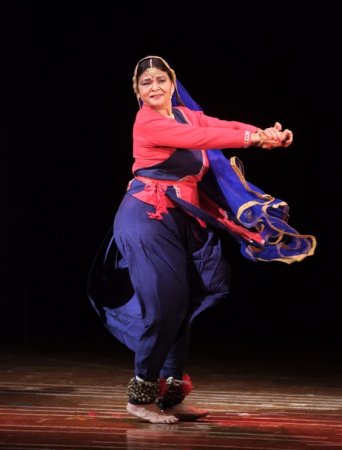 Shila Mehta Shila Mehta used the Charani style of Gujarat, to narrate the mythological story of Amba from Mahabharata, as the preface to Nimitta. Amba was married to Bhishma but he refused to accept her because of his oath to remain a bachelor. On return, she was also denied by her lover because she had gone to Bhishma. Eventually, she immolates herself in the sacrificial fire and is reborn as the eldest son of King Dhrupad as Shikhandi who becomes the Nimmita, a catalyst for Bhishma's death. Two of her disciples joined Shila Mehta to present this dance drama, in Charani style revived for Kathak by Shila Mehta. Shila is a well-known Kathak exponent renowned for her choreographic works and scholarship. She used the technical elements of Kathak like the Parans, Ladi, and Tihais to heighten veer rasa. Still, she somehow missed the valour required for Shikhandi as desired in her choreographic conviction. 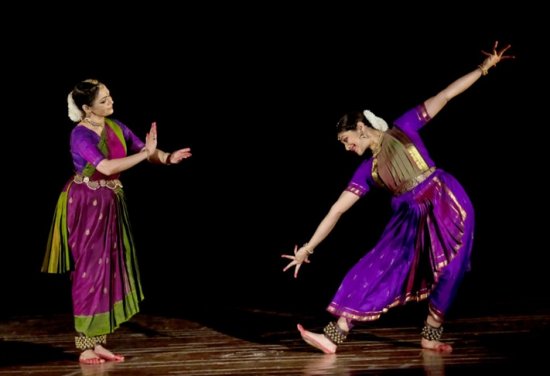 Rama & Dakshina Vaidyanathan 'Dwita', a Bharatanatyam presentation by Rama Vaidyanathan and her talented daughter and disciple Dakshina Vaidyanathan Baghel, reached the three-day festival to its climax. The opening of Dwita was a parallel between Lakshmi and Saraswati, with Rama dressed in white as Saraswathi and Dakshina in a red resplendent costume embodying Lakshmi, which also served as an invocation with Sanskrit shlokas like "Ya kundendu tushar haar dhavala" for Saraswati and "Om Shrim, Hrim..." for Lakshmi. Rama had conceived the Dwita of Lakshmi and Saraswati to explore the play of knowledge and initiatives in our lives. The balance of wealth and learning which is so crucial to our physical and emotional well-being, was conveyed quite convincingly by her. Next came solo Varnam-like pieces by both. 'Treem Trishulaya' by Dakshina was about the Trishul that Devi holds, and 'Ratna-Garbha' by Rama explored the relationship between man and the earth, where the earth is a womb from where the vegetation grows. Music for both was composed by Sudha Raghuraman. Dakshina portrayed Trishulini in raga Durga, rising from Muladhar to Sahasrar Chakra going through the Ida, Pingala, Kundalini and Sushumna Nadis while covering the entire space of the stage and freezing ultimately as 'Trishuluni / Batuk-Bharavi'! Rama on the other hand, was inspired by a seal from the Harappan civilisation for presenting Ratna Garbha, the womb of earth bearing precious gems. The earth is Payaswini and Uttara changing season after season. Both the choreographies were treated in detail like a Varnam studded with jathis, sargams and sahitya, respectively. The concluding part of Dwita was based on poetry from the Sangam era, which was about the mother and daughter relationship. It was the story of a mother who brings up her daughter lovingly by teaching her how to stand and walk, she bathes her and plaits her hair. She is so happy with her daughter, but one day she is shocked to see her with a stranger. She wants her daughter to be with her alone but then realizes that she should let her go. She thinks of a Veena which emanates sonorous swaras only when the wires are stretched, she imagines a pearl in the oyster which needs to be separated to glow. Eventually, she hugs her daughter and lets her go to chart her own course. Music by Dr S. Vasudevan in Bageshri and Shyam Kalyan enhanced the dance choreography by Rama, despite being pre-recorded. 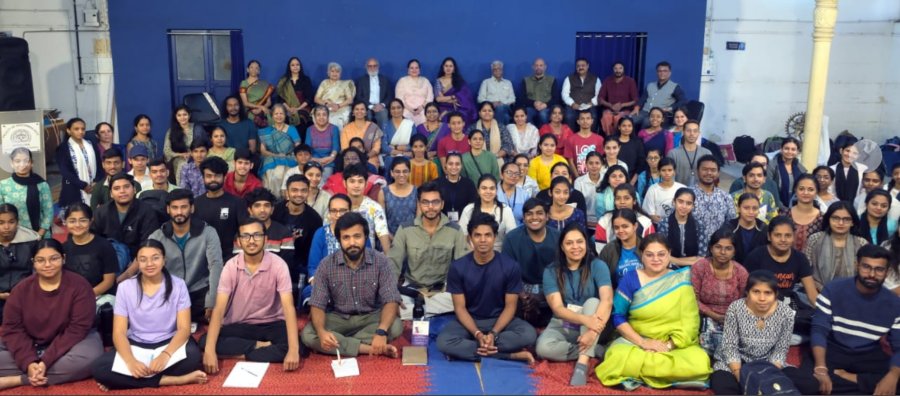 Speakers and students during Round Table Dialogue & Discussion The Round Table dialogues had stalwarts like Prof. Sitanshu Yashaschandra who opened by eulogizing Anjali Ben as an iconoclastic dancer, who dared to do the forbidden Navagraha composition of Muthuswami Dikshitar at the cost of dying young. He noticed the choking voice of Dr Parul Shah remembering her Guru and talked about the Guru Shishya Parampara before stating that tradition and innovation go hand in hand. He also talked about the pause and stillness in dance. 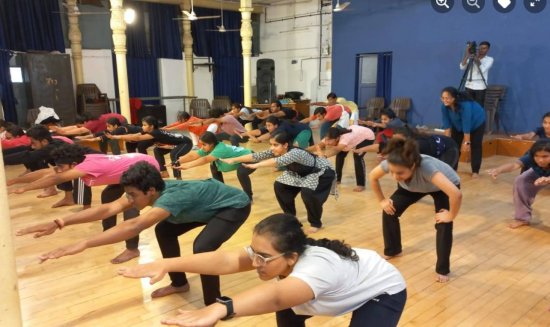 Kalaripayattu workshop Other speakers comprised Prof. Deepak Kannal, Prof Gaurang Bhavsar, Rama Vaidyanatha, Swati Datar, Dr Arshiya Sethi, Sujata Parsai, Sandhya Bordwekar, Arupa Lahiry, Dr Rajesh Kelkar, Vivek Kane, Dr Pramod Chavan, and this critic. Dr Parul Shah eloquently moderated this session. The Kalarippayattu workshop was conducted by Nikhil Varagiri from Dharwad, who not only taught this challenging martial art form to more than fifty students but also made them demonstrate it on the concluding evening at the CC Mehta Auditorium of the MS University and received thunderous applause. Three cheers for Dr Parul Shah and the Anjali Memorial Committee, Vadodara on imaginatively conceiving and flawlessly executing the 45th Nrityaparva. 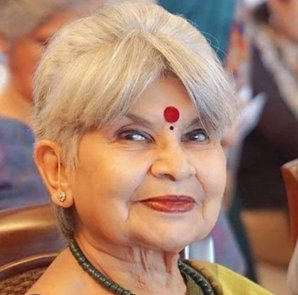 Manjari Sinha is a musicologist and an acclaimed classical music and dance critic. She has an MA in Sanskrit from Allahabad University, MA in Music from Vikram University, Ujjain; Sangeet Prabhakar in Hindustani Vocal, Tabla, Sitar and Kathak dance from Prayag Sangeet Samiti, Allahabad; and further training in Sitar under Guru Pt. Arvind Parikh in the lineage of Ustad Vilayat Khan. She has authored a book on Ustad Bade Ghulam Ali Khan, commissioned & published by Roli Books. She has contributed the chapter on Kathak for 'Indian Dance: the Ultimate Metaphor'. Her articles in English and Hindi on Music, Dance, Art & Culture are regularly showcased in a variety of leading journals and periodicals. |